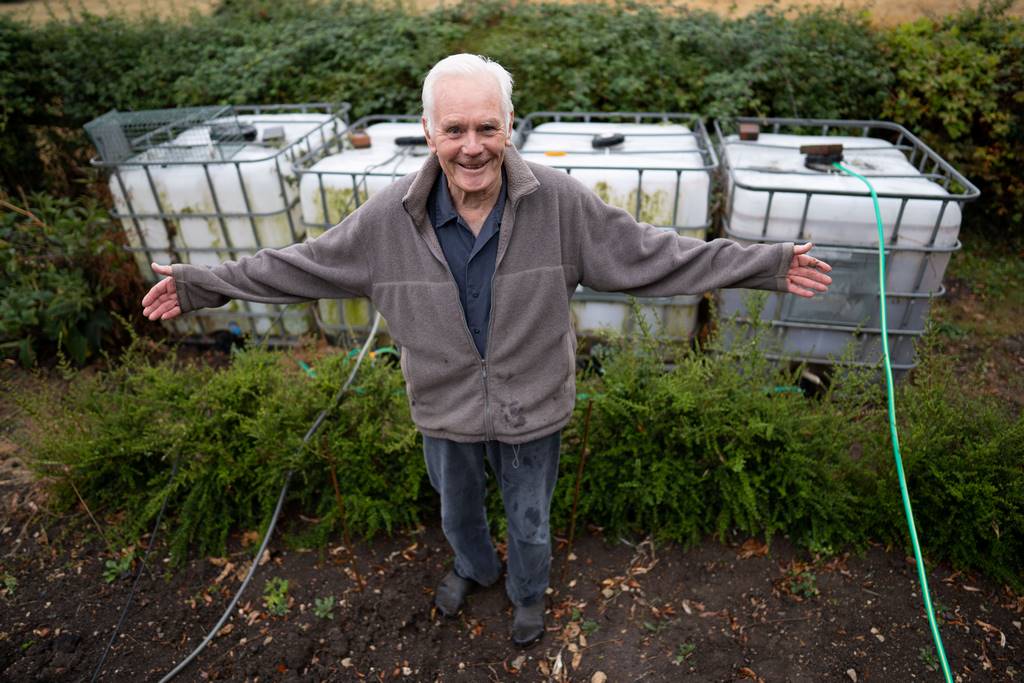Man Stores Rainwater Since 1976 and Has 6,000 Liters to Get Through Drought. WISE thinking? Yep.
By Andy Corbley -Aug 24, 2022Even though the English government recently announced a ban on garden hose watering in the west of the country, Peter Harden has kept right on hosing worry-free.
That’s because Harden has been storing rainwater in large catch thanks for almost 50 years, and with 6,000 liters (1,500 gallons) of water available to him, his paddock is the greenest on the block.
An 82-year-old retired teacher, Peter Harden has lived in his bungalow for 52 years, and said he installed his first rainwater catch tanks after a famous English drought in 1976.
The keen gardener noticed droughts in the UK were getting more intense and became inspired to take precautions by he and his wife’s holidays to Europe.
“Our holidays abroad in Europe over 50 years frequently included cultural visits to ancient Greek and Roman towns,” said Harden. “We were always impressed by the huge number of domestic underground cisterns that the Romans et al. pre-built to catch rainwater for very dry summers.”
“With this experience in mind, I gradually increased the number and size of my rainwater catch tanks until about 15 years ago when I had nine 375 liter capacity tanks fed directly by rainwater from the bungalow’s guttering.”
But why such dedication? Peter lives in one of the driest areas in the UK. The clay beneath his property in Ingoldsby, Lincolnshire, does hold water, but as soon as the UK gets a drought the clay starts to crack. Now the region is experiencing its worst drought in 26 years, and to protect municipal water reserves, a hose pipe ban has been introduced in parts of the West Country.
“We live in an area with one of the lowest mean rainfalls in the country. We get a circa of 22 inches per year,” said Harden, who about eight years ago supplemented his 9 catch tanks with two more, 1,000 liter (250 gallon) intermediate bulk containers, before adding another pair just recently.
The bulk water containers sit at the bottom of the garden and are filled directly by garden hose from some of the 375-liter catch tanks. “Using an electrically-powered submersible water pump, I pump water through a garden hose from one of the tanks through a spray attached to the garden hose,” he explained.
“As the level of water falls in the one tank it levels out in the other tanks through gravity feed through the interconnected pipes. “Three of my original 375-liter tanks have since become unserviceable and I am waiting to replace them. I also am trying to buy two more 1,000 liter bulk containers to increase my water storage volume.”
Not slowing down, he says he aims to store 9,000 liters soon.


Comments (8)
Shingle roofs have fiberglass, tar and gravel. After a few years they build up mildew between the joints. Although the rain water is pure, the possibility of contamination from the roofing material is present.
The same for Painted roofs. If you notice where there are vents through the roof they often show streaks as the paint wears away. Especially on older houses, sheets of lead are used around flashing to join uneven surfaces.
Acid rain is caused by a chemical reaction that begins when compounds like sulfur dioxide and nitrogen oxides are released into the air. These substances can rise very high into the atmosphere, where they mix and react with water, oxygen, and other chemicals to form more acidic pollutants, known as acid rain.
Acid rain is caused by a chemical reaction that begins when compounds like sulfur dioxide and nitrogen oxides are released into the air. These substances can rise very high into the atmosphere, where they mix and react with water, oxygen, and other chemicals to form more acidic pollutants, known as acid rain.
Much later in life I learned that it is better to avoid the 'first' rains, due to the harmful content that may be present in the atmosphere during the first rainfall.
I do my best to conserve water too. When it rains, I move my car to where there is no port, so it can get washed.
And when I take my little dog for a walk, he sprinkles/waters the lawn and plants around the area.
Cool, huh?
I do my best to conserve water too. When it rains, I move my car to where there is no port, so it can get washed.
And when I take my little dog for a walk, he sprinkles/waters the lawn and plants around the area.
Cool, huh?